Tushar Nagarajan
PerceptionLM: Open-Access Data and Models for Detailed Visual Understanding
Apr 17, 2025



Abstract:Vision-language models are integral to computer vision research, yet many high-performing models remain closed-source, obscuring their data, design and training recipe. The research community has responded by using distillation from black-box models to label training data, achieving strong benchmark results, at the cost of measurable scientific progress. However, without knowing the details of the teacher model and its data sources, scientific progress remains difficult to measure. In this paper, we study building a Perception Language Model (PLM) in a fully open and reproducible framework for transparent research in image and video understanding. We analyze standard training pipelines without distillation from proprietary models and explore large-scale synthetic data to identify critical data gaps, particularly in detailed video understanding. To bridge these gaps, we release 2.8M human-labeled instances of fine-grained video question-answer pairs and spatio-temporally grounded video captions. Additionally, we introduce PLM-VideoBench, a suite for evaluating challenging video understanding tasks focusing on the ability to reason about "what", "where", "when", and "how" of a video. We make our work fully reproducible by providing data, training recipes, code & models.
VITED: Video Temporal Evidence Distillation
Mar 17, 2025Abstract:We investigate complex video question answering via chain-of-evidence reasoning -- identifying sequences of temporal spans from multiple relevant parts of the video, together with visual evidence within them. Existing models struggle with multi-step reasoning as they uniformly sample a fixed number of frames, which can miss critical evidence distributed nonuniformly throughout the video. Moreover, they lack the ability to temporally localize such evidence in the broader context of the full video, which is required for answering complex questions. We propose a framework to enhance existing VideoQA datasets with evidence reasoning chains, automatically constructed by searching for optimal intervals of interest in the video with supporting evidence, that maximizes the likelihood of answering a given question. We train our model (VITED) to generate these evidence chains directly, enabling it to both localize evidence windows as well as perform multi-step reasoning across them in long-form video content. We show the value of our evidence-distilled models on a suite of long video QA benchmarks where we outperform state-of-the-art approaches that lack evidence reasoning capabilities.
SPOC: Spatially-Progressing Object State Change Segmentation in Video
Mar 15, 2025Abstract:Object state changes in video reveal critical information about human and agent activity. However, existing methods are limited to temporal localization of when the object is in its initial state (e.g., the unchopped avocado) versus when it has completed a state change (e.g., the chopped avocado), which limits applicability for any task requiring detailed information about the progress of the actions and its spatial localization. We propose to deepen the problem by introducing the spatially-progressing object state change segmentation task. The goal is to segment at the pixel-level those regions of an object that are actionable and those that are transformed. We introduce the first model to address this task, designing a VLM-based pseudo-labeling approach, state-change dynamics constraints, and a novel WhereToChange benchmark built on in-the-wild Internet videos. Experiments on two datasets validate both the challenge of the new task as well as the promise of our model for localizing exactly where and how fast objects are changing in video. We further demonstrate useful implications for tracking activity progress to benefit robotic agents. Project page: https://vision.cs.utexas.edu/projects/spoc-spatially-progressing-osc
BIMBA: Selective-Scan Compression for Long-Range Video Question Answering
Mar 13, 2025Abstract:Video Question Answering (VQA) in long videos poses the key challenge of extracting relevant information and modeling long-range dependencies from many redundant frames. The self-attention mechanism provides a general solution for sequence modeling, but it has a prohibitive cost when applied to a massive number of spatiotemporal tokens in long videos. Most prior methods rely on compression strategies to lower the computational cost, such as reducing the input length via sparse frame sampling or compressing the output sequence passed to the large language model (LLM) via space-time pooling. However, these naive approaches over-represent redundant information and often miss salient events or fast-occurring space-time patterns. In this work, we introduce BIMBA, an efficient state-space model to handle long-form videos. Our model leverages the selective scan algorithm to learn to effectively select critical information from high-dimensional video and transform it into a reduced token sequence for efficient LLM processing. Extensive experiments demonstrate that BIMBA achieves state-of-the-art accuracy on multiple long-form VQA benchmarks, including PerceptionTest, NExT-QA, EgoSchema, VNBench, LongVideoBench, and Video-MME. Code, and models are publicly available at https://sites.google.com/view/bimba-mllm.
Switch-a-View: Few-Shot View Selection Learned from Edited Videos
Dec 24, 2024Abstract:We introduce Switch-a-View, a model that learns to automatically select the viewpoint to display at each timepoint when creating a how-to video. The key insight of our approach is how to train such a model from unlabeled--but human-edited--video samples. We pose a pretext task that pseudo-labels segments in the training videos for their primary viewpoint (egocentric or exocentric), and then discovers the patterns between those view-switch moments on the one hand and the visual and spoken content in the how-to video on the other hand. Armed with this predictor, our model then takes an unseen multi-view video as input and orchestrates which viewpoint should be displayed when. We further introduce a few-shot training setting that permits steering the model towards a new data domain. We demonstrate our idea on a variety of real-world video from HowTo100M and Ego-Exo4D and rigorously validate its advantages.
Which Viewpoint Shows it Best? Language for Weakly Supervising View Selection in Multi-view Videos
Nov 13, 2024



Abstract:Given a multi-view video, which viewpoint is most informative for a human observer? Existing methods rely on heuristics or expensive ``best-view" supervision to answer this question, limiting their applicability. We propose a weakly supervised approach that leverages language accompanying an instructional multi-view video as a means to recover its most informative viewpoint(s). Our key hypothesis is that the more accurately an individual view can predict a view-agnostic text summary, the more informative it is. To put this into action, we propose a framework that uses the relative accuracy of view-dependent caption predictions as a proxy for best view pseudo-labels. Then, those pseudo-labels are used to train a view selector, together with an auxiliary camera pose predictor that enhances view-sensitivity. During inference, our model takes as input only a multi-view video -- no language or camera poses -- and returns the best viewpoint to watch at each timestep. On two challenging datasets comprised of diverse multi-camera setups and how-to activities, our model consistently outperforms state-of-the-art baselines, both with quantitative metrics and human evaluation.
Human Action Anticipation: A Survey
Oct 17, 2024
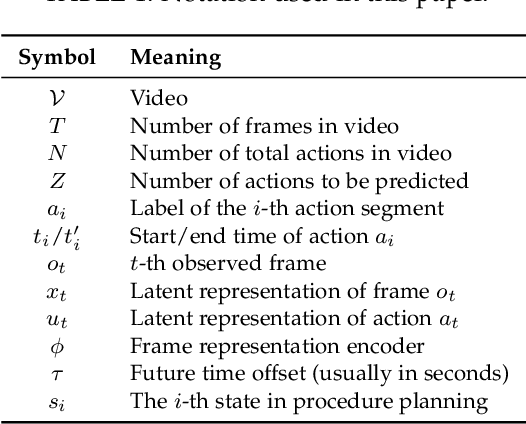
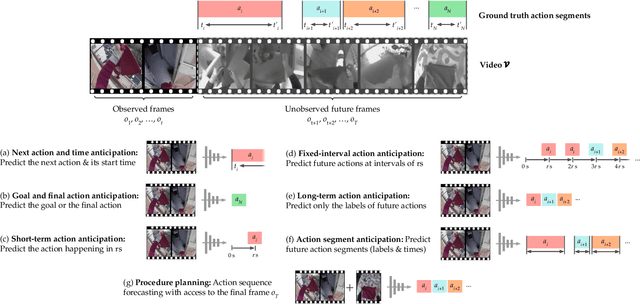
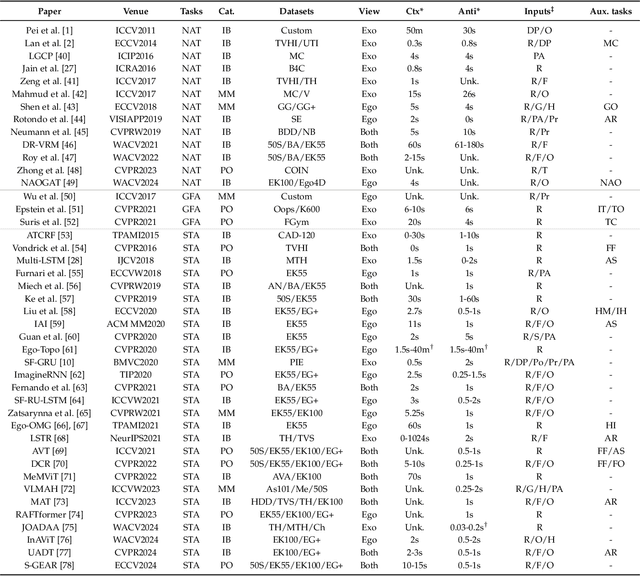
Abstract:Predicting future human behavior is an increasingly popular topic in computer vision, driven by the interest in applications such as autonomous vehicles, digital assistants and human-robot interactions. The literature on behavior prediction spans various tasks, including action anticipation, activity forecasting, intent prediction, goal prediction, and so on. Our survey aims to tie together this fragmented literature, covering recent technical innovations as well as the development of new large-scale datasets for model training and evaluation. We also summarize the widely-used metrics for different tasks and provide a comprehensive performance comparison of existing approaches on eleven action anticipation datasets. This survey serves as not only a reference for contemporary methodologies in action anticipation, but also a guideline for future research direction of this evolving landscape.
VEDIT: Latent Prediction Architecture For Procedural Video Representation Learning
Oct 04, 2024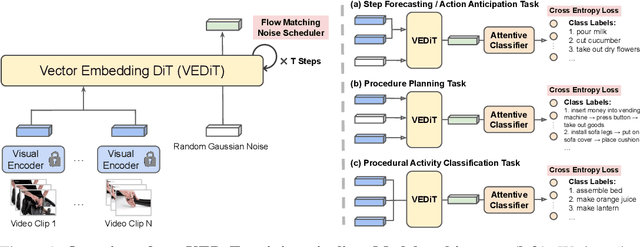

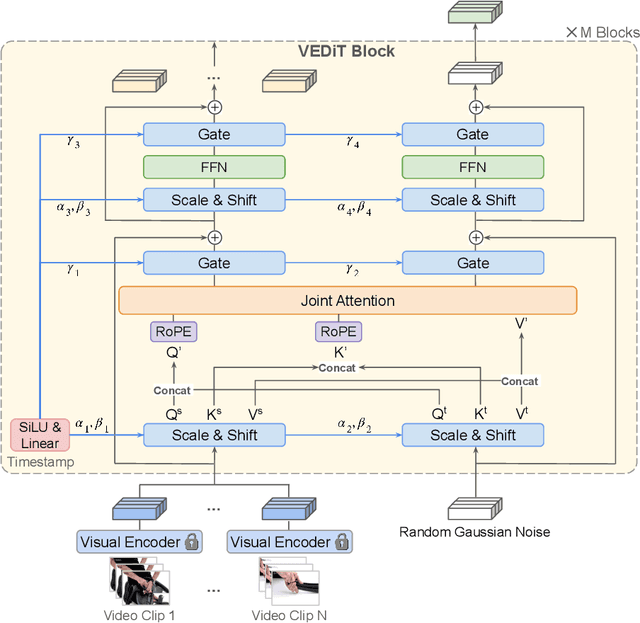
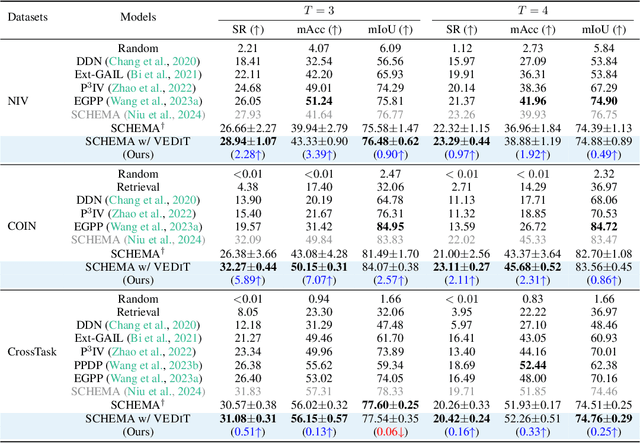
Abstract:Procedural video representation learning is an active research area where the objective is to learn an agent which can anticipate and forecast the future given the present video input, typically in conjunction with textual annotations. Prior works often rely on large-scale pretraining of visual encoders and prediction models with language supervision. However, the necessity and effectiveness of extending compute intensive pretraining to learn video clip sequences with noisy text supervision have not yet been fully validated by previous works. In this work, we show that a strong off-the-shelf frozen pretrained visual encoder, along with a well designed prediction model, can achieve state-of-the-art (SoTA) performance in forecasting and procedural planning without the need for pretraining the prediction model, nor requiring additional supervision from language or ASR. Instead of learning representations from pixel space, our method utilizes the latent embedding space of publicly available vision encoders. By conditioning on frozen clip-level embeddings from observed steps to predict the actions of unseen steps, our prediction model is able to learn robust representations for forecasting through iterative denoising - leveraging the recent advances in diffusion transformers (Peebles & Xie, 2023). Empirical studies over a total of five procedural learning tasks across four datasets (NIV, CrossTask, COIN and Ego4D-v2) show that our model advances the strong baselines in long-horizon action anticipation (+2.6% in Verb ED@20, +3.1% in Noun ED@20), and significantly improves the SoTA in step forecasting (+5.0%), task classification (+3.8%), and procedure planning tasks (up to +2.28% in success rate, +3.39% in mAcc, and +0.90% in mIoU).
Propose, Assess, Search: Harnessing LLMs for Goal-Oriented Planning in Instructional Videos
Sep 30, 2024
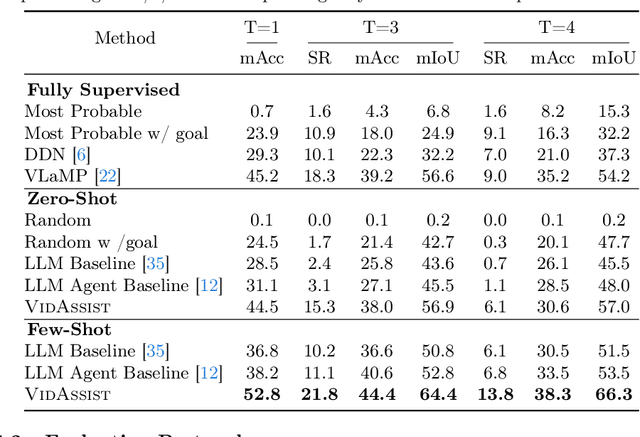

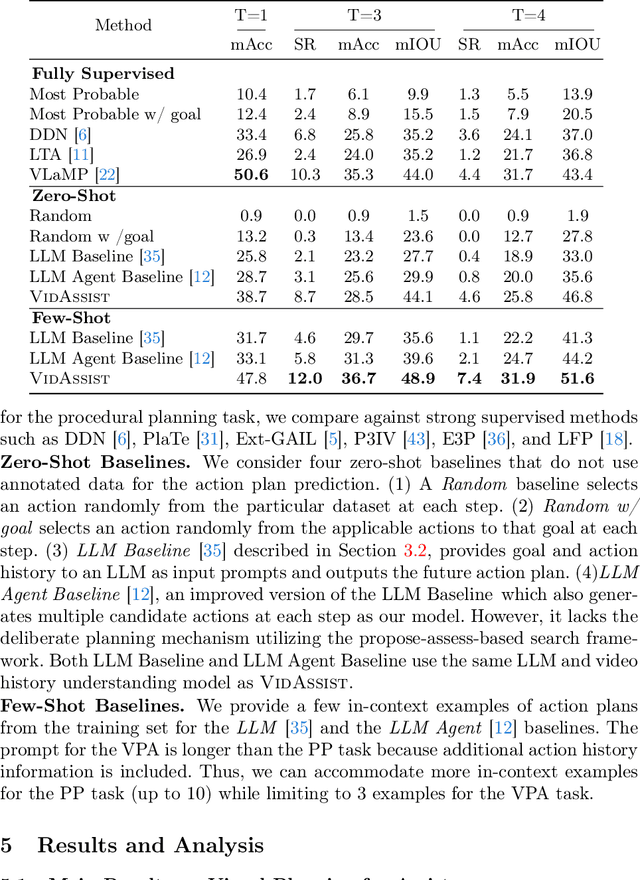
Abstract:Goal-oriented planning, or anticipating a series of actions that transition an agent from its current state to a predefined objective, is crucial for developing intelligent assistants aiding users in daily procedural tasks. The problem presents significant challenges due to the need for comprehensive knowledge of temporal and hierarchical task structures, as well as strong capabilities in reasoning and planning. To achieve this, prior work typically relies on extensive training on the target dataset, which often results in significant dataset bias and a lack of generalization to unseen tasks. In this work, we introduce VidAssist, an integrated framework designed for zero/few-shot goal-oriented planning in instructional videos. VidAssist leverages large language models (LLMs) as both the knowledge base and the assessment tool for generating and evaluating action plans, thus overcoming the challenges of acquiring procedural knowledge from small-scale, low-diversity datasets. Moreover, VidAssist employs a breadth-first search algorithm for optimal plan generation, in which a composite of value functions designed for goal-oriented planning is utilized to assess the predicted actions at each step. Extensive experiments demonstrate that VidAssist offers a unified framework for different goal-oriented planning setups, e.g., visual planning for assistance (VPA) and procedural planning (PP), and achieves remarkable performance in zero-shot and few-shot setups. Specifically, our few-shot model outperforms the prior fully supervised state-of-the-art method by +7.7% in VPA and +4.81% PP task on the COIN dataset while predicting 4 future actions. Code, and models are publicly available at https://sites.google.com/view/vidassist.
AMEGO: Active Memory from long EGOcentric videos
Sep 17, 2024



Abstract:Egocentric videos provide a unique perspective into individuals' daily experiences, yet their unstructured nature presents challenges for perception. In this paper, we introduce AMEGO, a novel approach aimed at enhancing the comprehension of very-long egocentric videos. Inspired by the human's ability to maintain information from a single watching, AMEGO focuses on constructing a self-contained representations from one egocentric video, capturing key locations and object interactions. This representation is semantic-free and facilitates multiple queries without the need to reprocess the entire visual content. Additionally, to evaluate our understanding of very-long egocentric videos, we introduce the new Active Memories Benchmark (AMB), composed of more than 20K of highly challenging visual queries from EPIC-KITCHENS. These queries cover different levels of video reasoning (sequencing, concurrency and temporal grounding) to assess detailed video understanding capabilities. We showcase improved performance of AMEGO on AMB, surpassing other video QA baselines by a substantial margin.
 Add to Chrome
Add to Chrome Add to Firefox
Add to Firefox Add to Edge
Add to Edge